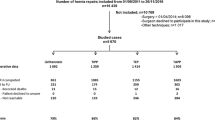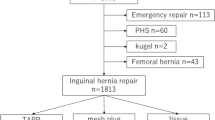Abstract
Background
Surgical management of an asymptomatic inguinal hernia is controversial but given that most of the patients will develop symptoms, the hernioplasty seems to be a reasonable option. We aimed to compare postoperative outcomes after transabdominal preperitoneal (TAPP) repair between patients with symptomatic bilateral hernia (SBH) and patients with one symptomatic hernia and an asymptomatic contralateral hernia (ACH).
Methods
A consecutive series of patients undergoing bilateral laparoscopic TAPP from July 2014 to June 2018 were included. Symptomatic hernia was defined as a groin bulge associated to pain and altered patient’s daily activities. Patients were divided into two groups, those with SBH and those with one symptomatic hernia in whom an ACH was diagnosed by physical examination or ultrasound when clinical assessment was inconclusive. Demographics, operative, and postoperative outcomes were compared. Quality of life (QoL) was assessed before and after surgery in both groups.
Results
A total of 305 bilateral TAPP repairs were included; 102 (33, 4%) patients had SBH and 203 (66, 6%) had ACH. There were no significant differences between groups regarding age, gender, body mass index, active smoking, and comorbidities. Operative time (SBH: 125 vs. ACH: 132 min, p = 0.13) and overall 30-day morbidity were similar between groups (SBH: 14, 7% vs. ACH: 13, 8%, p = 0.82). After a mean follow-up of 30 (10–48) months, the recurrence rate was 1, 4% and 2, 2% in SBH and ACH, respectively (p = 0.53). QoL after surgery improved significantly and similarly in both groups.
Conclusion
Bilateral laparoscopic TAPP in the setting of an asymptomatic hernia did not increase morbidity and had similar outcomes when compared to patients with bilateral symptoms. A comprehensive preoperative evaluation of the contralateral groin should be routinely performed, mainly by physical examination, and a bilateral repair may be proposed if an asymptomatic contralateral hernia is detected.
Similar content being viewed by others
References
Rutkow IM (2003) Demographic and socioeconomic aspects of hernia repair in the United States in 2003. Surg Clin North Am 83:1045–1051
Bittner R, Montgomery MA, Arregui E, Bansal V, Bingener J, Bisgaard T, Buhck H, Dudai M, Ferzli GS, Fitzgibbons RJ, Fortelny RH, Grimes KL, Klinge U, Koeckerling F, Kumar S, Kukleta J, Domanto D, Misra MC, Morales-Conde S, Reinpold W, Rosenberg J, Singh K, Timoney M, Weyhe D, Chowbey P (2015) Update guidelines on laparoscopic (TAPP) and endoscopic (TEP) treatment of inguinal hernia (International Endohernia Society). Surg Endosc 29:289–321
Bracale U, Melillo P, Pignata G, Di Salvo E, Rovani M, Merola G, Pecchia L (2012) Which is the best laparoscopic approach for inguinal hernia repair: TEP or TAPP? A systematic review of the literature with a network meta-analysis. Surg Endosc 26:3355–3366
The HerniaSurge Group (2018) International guidelines for groin hernia management. Hernia 22:1–165
Fitzgibbons RJ, Giobbie-Hurder A, Gibbs JO, Dunlop DD, Reda DJ, McCarthy M, Neumayer LA, Barkun JS, Hoehn JL, Murphy JT, Sarosi GA, Syme WC, Thompson JS, Wang J, Jonasson O (2006) Watchful waiting vs. repair of inguinal hernia in minimally symptomatic men: a randomized clinical trial. JAMA 295:285–292
Fitzgibbons RJ, Ramanan B, Arya S, Turner SA, Li X, Gibbs JO, Reda DJ, Investigators of the original trial (2013) Long-term results of a randomized controlled trial of a nonoperative strategy (watchful waiting) for men with minimally symptomatic inguinal hernias. Ann Surg 258:508–515
Chung L, Norrie J, O’Dwyer P (2011) Long-term follow-up of patients with painless inguinal hernia from a randomized clinical trial. Br J Surg 98:596–599
Peña ME, Dreifuss NH, Schlottmann F, Sadava EE (2019) Could long-term follow-up modify the outcomes after laparoscopic TAPP? A 5-year retrospective cohort study. Hernia 23:693–698
Weber-Sanchez A, Weber-Alvarez P, Garteiz-Martinez D (2016) Laparoscopy and bilateral hernias. J Surg Transplant Sci 4(1):1019
Weber A, Garteiz D, Valencia S (2001) Epidemiology of inguinal hernia: a useful aid for adequate surgical decisions. In: Bendavid R, Abrahamson J, Arregui M, Flament JB, Phillips E (eds) Abdominal wall hernias principles and management. New York, Springer, pp 109–115
Hay JM, Boudet MJ, Fingerhut A, Poucher J, Hennet H, Habib E, Veyrieres M, Flamant Y (1995) Shouldice inguinal repair in the male adult: the gold standard? A multicenter controlled trial in 1578 patients. Ann Surg 222:719–727
Aasvang EK, Gmaehle E, Hansen JB, Gmaehle B, Forman JL, Schwarz J, Bittner R, Kehlet H (2010) Predictive risk factors for persistent postherniotomy pain. Anesthesiology 112:957–969
O’Dwyer PJ, Norrie J, Alani A, Walker A, Duffy F, Horgan P (2006) Observation or operation for patients with an asymptomatic inguinal hernia: a randomized clinical trial. Ann Surg 244:167–173
Schmedt CG, Daubler P, Leibl BJ, Kraft K, Bittner R, Laparoscopic Repair Hernia Study Team (2002) Simultaneous bilateral laparoscopic inguinal hernia repair: An analysis of 1336 consecutive cases at a single center. Surg Endosc 16:240–244
Wauschkuhn CA, Schwarz J, Boekeler U, Bittner R (2010) Laparoscopic inguinal hernia repair: gold standard in bilateral hernia repair? Results of more than 2800 patients in comparison to literature. Surg Endosc 24:3026–3030
Lal P, Philips P, Chander J, Ramteke VK (2010) Is unilateral laparoscopic TEP inguinal repair a job half done? The case of bilateral repair. Surg Endosc 24:1737–1745
Malouf PA, Descallar J, Berney CR (2017) Bilateral totally extraperitoneal (TEP) repair of the ultrasound-diagnosed asymptomatic contralateral inguinal hernia. Surg Endosc 32:955
Jacob DA, Hackl JA, Bittner R, Kraft B, Kockerling F (2015) Perioperative outcomes of unilateral versus bilateral inguinal hernia repairs in TAPP technique: analysis of 15,176 cases from the Herniamed Registry. Surg Endosc 29:3733–3740
Author information
Authors and Affiliations
Corresponding author
Ethics declarations
Disclosures
Drs Nicolás H. Dreifuss, María E. Peña, Francisco Schlottmann, and Emmanuel E. Sadava have no conflicts of interest or financial ties to disclose.
Additional information
Publisher's Note
Springer Nature remains neutral with regard to jurisdictional claims in published maps and institutional affiliations.
Rights and permissions
About this article
Cite this article
Dreifuss, N.H., Peña, M.E., Schlottmann, F. et al. Long-term outcomes after bilateral transabdominal preperitoneal (TAPP) repair for asymptomatic contralateral inguinal hernia. Surg Endosc 35, 626–630 (2021). https://doi.org/10.1007/s00464-020-07425-7
Received:
Accepted:
Published:
Issue Date:
DOI: https://doi.org/10.1007/s00464-020-07425-7




